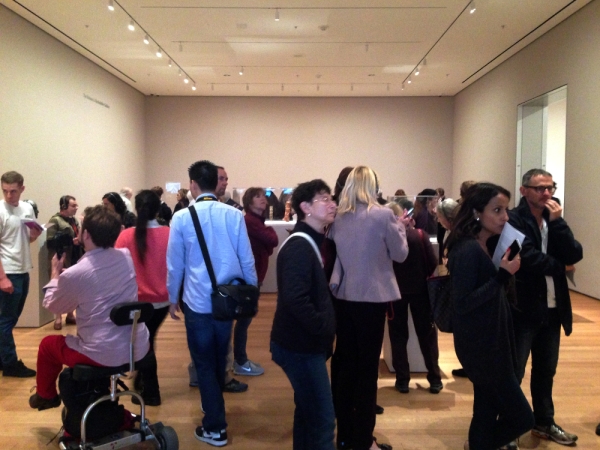09 November 2015
Picasso Sculpture
Museum of Modern Art
14 September 2015 – 07 February 2016
by Loren Nosan
NEW YORK — I have a fuzzy memory of going into a gallery in Aspen, Colorado many years ago, and seeing an extraordinary, brutal ceramic sculpture. I can’t remember what it depicted. I don’t know what gallery it was. I was surprised by the label, because I hadn’t known that Picasso made sculptures.
Years later, at the Philadelphia Museum of Art, an encounter with an Absinthe Glass confirmed what that earlier memory had vaguely suggested–namely, that while the “greatness” of Picasso’s paintings left me a bit numb, I totally vibe with his sculptures. That small glass of absinthe contained a brilliance I could recognize, and left me smiling conspiratorially. An ugly thing, really–wracked, uneven, goofily askew, dotted with haphazard paint that looked like a rash or venereal disease, and topped with the grotesque effigy of a sugar cube. Sculpture differs from painting, of course, due to its participation in the world of three-dimensions that we inhabit. As if to reinforce this kinship, a real absinthe spoon is thrust into the painted bronze assemblage, bringing home the horror and hilarity of this vessel, with its disturbing tendency to evoke the gaping mouth it’s meant to serve.
I was looking forward to a visit with this Absinthe Glass, as I rode the escalators up to the fourth floor of the MOMA on what I thought would be a quiet Tuesday in the galleries. Picasso Sculpture is, I gather, a “blockbuster show,” so it wasn’t quiet at all up there–in fact, it was thronged. The show begins and ends with a group of fabricated steel cutouts in the entryway, which could barely be seen through the crowd of people milling about them. Oh well. I braced myself, and entered the first gallery, the requisite grouping of ho-hum first efforts at sculpture by “the master,” kicking off the chronologically-ordered retrospective.
Who saves this shit? Who knows that Picasso is going to end up being “Picasso?”
Questions for another time. For now, I move on to the second gallery, where I am thrilled to be greeted by my old friend, the Absinthe Glass, and five of its compatriots, who, I am informed by the signage (which, graciously, is limited and restrained throughout the exhibition), were cast in an edition of six, and are reunited here for the first time since they left the artist’s studio. Each bronze has been given a different surface treatment–various combinations of solid and dotted planes. One particularly striking version, on loan from the Centre Pompidou, appears to have either been left unpolished, or coated with sand, and then adorned only with a band of milky off-white paint at the base. The opportunity to see the whole form without the disruption and increased ambiguity that results from the painting provides reciprocal enrichment to the viewing experience.
In the same room as the Absinthe Glasses are the iron wall relief, Guitar, 1914, and its cardboard predecessor, Still Life with Guitar. Their juxtaposition provides a golden opportunity for understanding the restlessness and immediacy with which Picasso approached sculpture throughout his lifetime. Still Life with Guitar is a glorious mess. The cardboard used to create it evinces smudges of former use. The loosely evoked table’s former life as a box lid can be traced in the staples that once held a corner in place. Un-trimmed ends dangle off droopy twine suggestions of strings, and the rolled tube that stands in for the sound hole is spliced onto its backing with a technique worthy of a precocious first-grader. The finished steel version, Guitar, owes its insouciance entirely to this tossed-off precursor. Picasso wisely retained the splice and stick detail of the sound hole in this otherwise cleaned-up facsimile. Without it, the impatience of creation that so enlivens his best sculptural works might have been lost.
This impatience–an almost reckless will to form–was the biggest payoff of the show for me. It is exciting and refreshing to see an artist abandon himself to the process of creation. When that artist is the mythologized and irreproachable Picasso, the pleasure is almost perverse. The retrospective, or career survey, which, when deployed traditionally, serves to tell a linear story about an artist, the progression of their work, and their place in the cannon, can sometimes do more to take the featured artist off the proverbial pedestal than shore him or her up on it. The format can be used for good and for ill, and Picasso Sculpture is a resounding example of the former. Viewing the show was an empowering experience, and I left feeling a sense of permissiveness. Taking risks ensures that there are going to be as many misses as there are hits. Get thee to thy studio, and make some shit!
